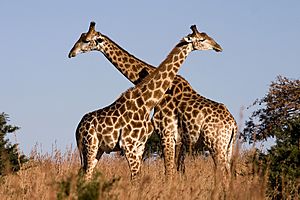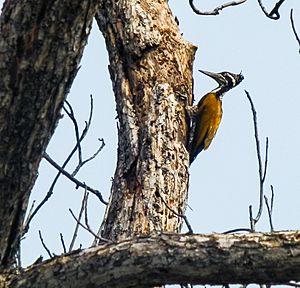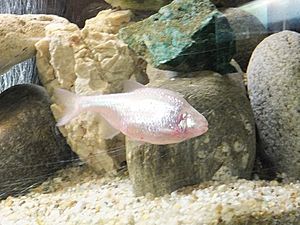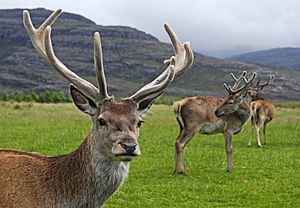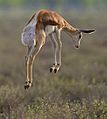Adaptation facts for kids

Adaptation is how a living thing, like an animal or a plant, changes over many generations to live better in its habitat (its home environment). It's a basic idea in biology.
When we talk about adaptation, we often mean a special feature that helps an animal or plant survive. Look at the bird beaks in the picture. They show how different birds have different ways of life. But it's not just the beak that changes! If a bird eats different food, its digestive system, claws, wings, and even its natural behavior also change. So, for big adaptations, a whole group of features changes together.
Adaptation happens because the animals or plants that are best suited to their environment are more likely to live long enough and have babies. This process is called natural selection.
Contents
How Adaptations Help in the Environment
All adaptations help living things survive in their ecological niches, which are their specific roles and places in the environment. These helpful traits can be:
- Structural adaptations: These are physical parts of an organism. Think about its shape, what covers its body (like fur or scales), or its internal organs. Things like camouflage (blending in) and mimicry (looking like something else) are also structural adaptations.
- Behavioral adaptations: These are things an organism does. They can be instincts it's born with, like hibernation (sleeping through winter) or migration (moving to a different place). They can also be things an animal learns.
- Physiological adaptations: These are special things an organism's body can do. For example, making venom, secreting slime, turning towards light (phototropism), using echolocation (like bats), or keeping its body temperature steady (regulating temperature).
Woodpeckers are a great example of how many features work together for a successful way of life:
- Their bill is like a chisel and stays sharp. They use it to find grubs (insect babies) under tree bark, to make holes for nests, and to tap on trees to show other woodpeckers their territory.
- They have long, sticky tongues. These help them grab insect grubs hidden under the bark.
- Just before a woodpecker's beak hits the wood, a special clear eyelid (called a nictitating membrane) closes. This protects its eye from flying bits of wood. Their nostrils are also small slits covered with feathers to keep debris out.
- A woodpecker's brain is small and protected by spongy plates inside its skull. These plates absorb the shock from pecking. The upper part of their beak is shorter, which helps direct the impact force away from the brain. They also have a special bone called the hyoid bone. It goes from their beak, loops over the top of their skull, and surrounds their brain, keeping it in place.
- Woodpeckers have special feet called zygodactyl feet. They have four toes: two point forward, and two point backward. This helps them grip tree trunks and branches very well. They can even walk straight up a tree!
- Their tails are stiff and strong. This helps them balance and perch firmly on vertical surfaces.
Different Kinds of Adaptations
Features Without a Clear Use Anymore
Not every part of an animal or plant is an adaptation that helps it right now. Some features show what the species was like in the past. For example, animals that live in dark caves often lose their color and eyesight over a long time. But they might still have tiny, unused eyes. Another example is a penguin's wings. They might have been used for flying a long, long time ago. Scientists think that adaptations that are no longer useful either become vestigial organs (like the human vermiform appendix) or change to do something different (like the tiny bones in our ear, called ear ossicles, which used to be part of a reptile's jaw).
Adaptations That Do Many Things
Many adaptations have more than one job. This is often why some features become so important that they almost define a species.
For example, a horse's legs are not just for running; they are also a main way to defend itself. A horse's kick can be very powerful! The antlers of male deer are used to attract mates (a sexual function) and also to fight off predators.
The large brain of humans is used for talking, thinking, and solving problems.
Bird feathers are not only for flying. They also help birds stay warm, control their body temperature, and even send signals to other birds.
Cool Facts About Adaptation
- Honeybees have amazing adaptations! They can communicate where to find nectar to other bees by doing a special dance. They can also feel the earth's magnetic field and even detect special waves in the air that tell them a thunderstorm is coming!
- African bullfrogs build homes out of mucus (a slimy substance) to survive the dry season.
- Roadrunners, kangaroo rats, and some gazelles can live their whole lives without drinking water. They get all the water they need from their food!
- Peacock flounders can change their patterns and colors to match their surroundings in the ocean. They can do this in just a few minutes!
- Alaskan wood frogs stop breathing, and their hearts stop beating when their bodies freeze solid in the winter. This helps them survive temperatures as low as -80 degrees Fahrenheit!
- Lungless salamanders breathe through their skin. They absorb oxygen right from the air around them.
- The horned lizard, also called the horny toad, can shoot blood from its eyes when a predator tries to attack it!
- The opossum can pretend to be dead to make predators go away. They can also resist snake venom.
Related pages
Images for kids
-
Some generalists, like birds, can adapt to urban areas.
-
Pictures A and B show real wasps; the others show things that look like wasps (Batesian mimics): three hoverflies and one beetle.
-
An Indian peacock showing off its beautiful tail.
-
The feathers of Sinosauropteryx, a dinosaur, were used for keeping warm. Later, feathers helped birds fly!
See also
 In Spanish: Adaptación biológica para niños
In Spanish: Adaptación biológica para niños


